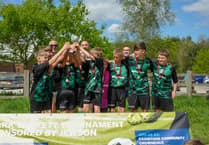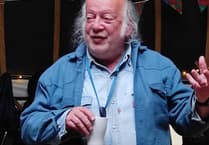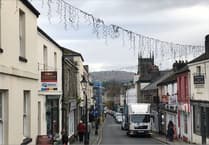STANDING proudly with fellow members of the Royal Marines' Association on Remembrance Sunday this year was a man who will never forget those comrades he served with helping to defend this country during its most perilous hour.
Former Royal Marine gunner Tom Cadwallader may have a leg injury, requiring a stick to help him get around, and deafness in one ear — both disabilities caused during the second world war — but there is no doubting his fighting and indomitable spirit.
This Sunday (December 18) Tom will be 91 but thoughts of his wartime experiences more than 70 years ago are never far from his mind at his Tavistock home.
Tom Cadwallader (a name he is proud of as Cadwaladr was a seventh century king, the last Welsh king to claim lordship over all of Britain) was born in Preston in 1920 in humble circumstances.
'I was delivered by a neighbour on a pile of newspapers on the kitchen floor,' he smiled. 'There were no NHS midwives in those days!'
It was no surprise that he grew up to join the military as his father, also called Tom, served with the Royal Marines Light Infantry after joining them in 1892, fought in the Boer War and completed 21 years' service to earn his pension — only to be recalled for a further five because of the first world war, seeing action in the Dardanelles campaign.
After leaving school at 14 and doing various jobs, Tom junior joined up aged 18 in December 1938 and in January 1939 was sent to the Royal Marine barracks in Deal, Kent, for basic training.
On completion he was transferred to Stonehouse Barracks in Plymouth and HMS Verity to learn gunnery and semaphore before reporting to the depot ship HMS Iron Duke with the Home Fleet in Scapa Flow, off the north east coast of Scotland.
The second world war, which started in September 1939, was now well underway and Tom was ordered to join the light cruiser HMS Newcastle, which was returning from arduous Russian convoy duty.
Tom is particularly fond of his time on HMS Newcastle, which saw more days at sea than any other Royal Naval ship during the war. The ship, along with HMS Suffolk, chased three German destroyers — including the Scharnhorst and Gniesau — in the seas between Norway and Iceland before suffering severe damage due to high, rough seas and being forced to return for repairs to the shipyard at Hepburn in County Durham.
But it was not long before Tom saw action when HMS Newcastle was anchored in Plymouth Sound. He was a member of a Royal Marine detail that boarded the French submarine Surcouf, then the world's largest submarine, which the French refused to hand over — the British feared she would end up in German hands through the Vichy French government. During the skirmish two British officers and a Frenchman died.
In the bombing blitz of Plymouth, which started in summer 1940, HMS Newcastle, anchored in Plymouth Sound with Tom aboard, fought back with her ack-ack guns to defy the Luffwaffe.
Years later, when Tom was working in the building trade in Plymouth, a man asked him how he had lost his hearing and what he had done during the war.
'It turned out that the man I was talking to was the Mayor of Plymouth and when I told him about my involvement with the gun batteries and HMS Newcastle he told me that it was HMS Newcastle that saved Plymouth from much more damage.'
In November Tom was aboard the light cruiser in a convoy to take vital supplies and 200 RAF personnel to the Mediterranean island of Malta and help relieve the siege by the Axis forces. Operation Collar, as the convoy was known. saw his ship involved with a brief engagement with an Italian fleet.
While on duty in Malta, Tom remembers the constant air raids by the Germans.
'Talk about Roger Bannister — I never saw anyone run as fast in my life as the Maltese when there was an air raid on,' smiled Tom.
Four days out (of Alexandria) in June 1942, HMS Newcastle was torpedoed by a German E-boat, blowing a hole through her bows.
Tom remembers: 'I was on the upper deck, I must have been the only bloke at that end. Two destroyers nearby were sunk and I saw one of them go down. They must have hit a magazine and the next thing I heard was the men screaming. She must have gone down in five minutes.'
When HMS Newcastle was hit Tom was flung in the air and came crashing down on the deck.
'I was knocked unconscious and they found me on my knees. The next thing I remembered I woke up in the ship's hospital and was there for two or three days.'
The crew saved the ship, which returned to Alexandria at four knots where she could not be repaired but was offered facilities to make her own. This meant building an additional wooden bulkhead, strengthened by concrete, behind the damage.
She limped up the Suez Canal and then to India. At Bombay, incredibly, Tom was flung into the air again! As the ship had lost its anchorage the plan was to do a windless operation to attach a cable to a bollard shoreside. While a crew of Royal Marines and sailors turned the winch a sudden swell hit the ship, throwing the winch men around, including Tom, who again landed hard on deck and was taken to a Bombay hospital to recover.
HMS Newcastle continued to limp on via ports in Ceylon, South Africa and Brazil, finally arriving in October at Brooklyn Navy Yard, New York, where new bows were built by March 1943. While he was in New England he stayed briefly with an American family. He said it was really strange because there were cotton mills and many Americans had a Lancastrian accent as they had emigrated from Britain to find work.
In December Tom's ship arrived in Plymouth and the HMS Newcastle crew were 'paid off.'
The next month he was drafted to HMS Renown, which had Prime Minister Winston Churchill on board, bound for Halifax, New Brunswick, to meet US?President Frankin D Roosevelt in Quebec to discuss Allied war policy.
'I saw Winston a few times on board and he even said "Good morning" to me when we were passing. He was a nice bloke. It was his birthday and I remember the ship's chef baked him a cake. I think he was awarded a British Empire Medal for that,' laughed Tom.
Again Churchill sailed with HMS Renown when she set sail for Alexandria in Egypt and onto Yalta in the Black Sea as the premier had his famous meeting with the USA president and Russian leader Stalin.
At Colombo in Ceylon Tom and other Royal Marines were transferred to the light cruiser HMS Ceylon to join the South East Asia Command. Ceylon joined up with an American and French fleet and harassed the Japanese from Colombo to Perth, Australia, including bombarding enemy oil refineries in Sumatra.
Eventually the war in the Far East drew to an end and Tom was with fellow Royal Marines that took part in a victory parade, with Earl Mountbatten, Commander in Chief of SEAC, taking the salute. He was also one of the British force who took the surrender of 2,000 Japanese troops at Penang.
After HMS Ceylon left Malaya she made her way back to Trincomalee in Ceylon (Sri Lanka) searching islands along the way to ensure there were no Japanese left, who did not know of their country's surrender, before the ship returned to Plymouth.
On his birthday on December 18 1946 Tom returned to Lancashire and there he met his wife-to-be Mary in the Bluebell pub, Preston. They had three daughters, Anne, Jean and Elaine, and Tom is now a grandfather and great-grandfather.
After the war he went into the building trade and despite leaving school with few qualifications in the 1950s he took an international correspondence course to became a civil engineer and eventually a contracts manager with a national building firm.
He was involved in building more than 3,000 houses in Plymouth, the city he helped to defend and which was devastated by German bombing.
Other major projects, included the conversion of the old Fort Picklecombe in South East Cornwall, and he worked for an American building company, which involved spending time on projects in the Middle East.
His beloved wife Mary died eleven years ago.
Now in his nineties Tom is still a keen member of the Tavistock branch of the Royal Marines' Association, although he is not so mobile now.?He wants to wish his friend Len 'Sticks' Chester, whom he first met when Len was a bugler when they were aboard HMS Iron Duke, 'all the best' as he has not seen him for a while.
Tom sums up his wartime experiences by saying: 'There were some things you see you don't want to think about too much, but I know I was lucky to get away with it when many of my mates died.'


-and-Sally-Ann-(visitor-experience-officer)-trying-ou.jpeg?width=209&height=140&crop=209:145,smart&quality=75)

Comments
This article has no comments yet. Be the first to leave a comment.